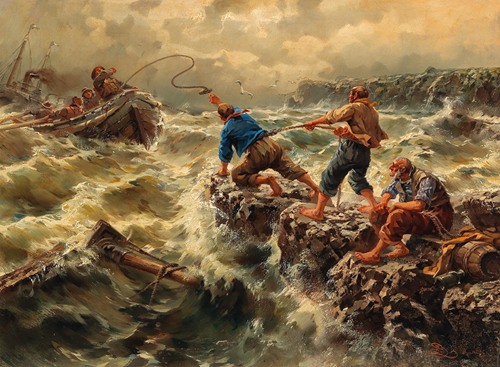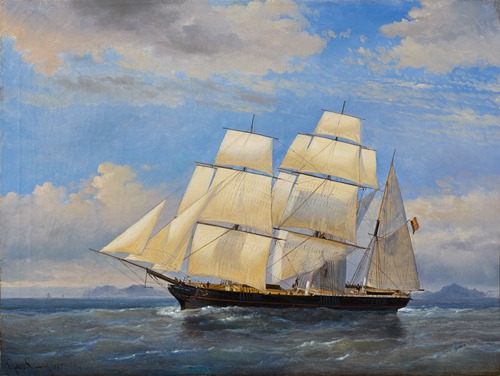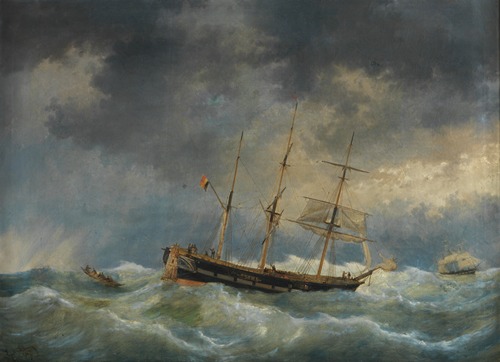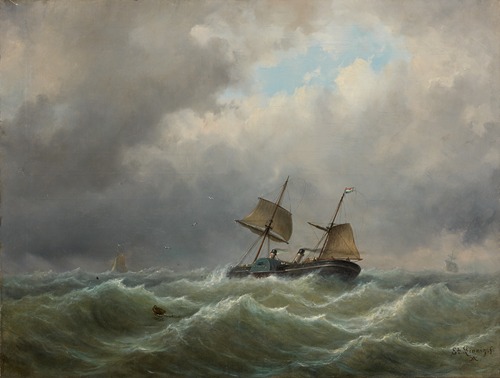

Egide Linnig
Egide Linnig or Egidius Linnig was a Belgian painter, draughtsman and engraver who is best known for his marine art and occasional genre scenes. He was one of the first realist engravers in Belgium.
Egide Linnig was born in Antwerp as the son of Pieter-Josef Linnig (born in Aschbach, Rhineland-Palatinate in Germany) and Catharina Josephina Leys. His father was a cabinetmaker. He had two older brothers (Jan Theodoor) Jozef Linnig and Willem Linnig the Elder who both became painters and engravers.
From 1834 Linnig studied at the Antwerp Academy of Fine Arts. Linnig was not happy with the emphasis placed on history painting by Mattheus Ignatius van Bree, the director of the Academy. Linnig was from the start more attracted to the marine genre and took advantage of van Bree’s death in 1839 to change his teacher to Jacques van Gingelen, a landscape painter and engraver. Linnig’s classmates and contemporaries during those years included François Lamorinière, Hendrik Frans Schaefels, Lucas Victor Schaefels, Louis Van Kuyck, Karel Verlat and Henri Adolphe Schaep. During his studies at the Academy, Linnig made many works from life, particularly of the Scheldt river.
While still enrolled at the Academy, Linnig participated in the Triennial Salon of Antwerp in 1840 exhibiting two marine paintings, Fishing for Herring on the Dogger Bank and Coast near Zierikzee. In 1842 Linnig decided to put an end to his academic studies. In the summer of the following year he joined the crew of fishing boats in order to study all ship maneuvers in detail. Linnig would in later years continue to take small sea trips for inspiration. One of the trips inspired him to the painting The brig 'Timor' shipwrecked off the English coast, which he exhibited at the Triennial Salon in Brussels in 1842.
In 1844, the year of his marriage, Linnig and his brother Willem spent some time in The Hague. In the Mauritshuis museum in The Hague, he studied the works of old and contemporary masters. Linnig later wrote that this trip to The Netherlands was decisive for the development of his conception of art and that this new conception was reflected in his composition Shipwreck on the English coast. He submitted this work to the 1845 Triennial Salon in Brussels. In 1847 Linnig sailed to Norway. In or shortly before 1848 he moved from Antwerp to St Willibrords.
Linnig presented four works at the Antwerp Salon of 1849. These were ordinary marines as well as ship portraits. From 1849 onwards Linnig regularly exhibited in Germany, where his marines met with success and were collected by several museum. In the late 1840s and early 1850s Linnig participated a total of three times in the "Exhibition of Living Masters" in the Netherlands with the following works: The wreckage of a Sardinian vessel (The Hague, 1847), Storm (Rotterdam, 1848) and The wintering of Barends and van Heemskerk on Nova Zembla. The last work was inspired by the poem of the Dutch poet Hendrik Tollens on the 16th century shipping disasters of Dutch ships near Novaya Zemlya (The Hague, 1851).
From the 1850s onwards Linnig produced many marines. These were either general genre scenes or scenes depicting a named ship playing a principal role in the action. The latter were a form of combination between a ship portrait and general marine painting and were usually made on the commission of shipping companies and ship captains. An example of the latter category is The three-master Constant off the coast of New Guinea. It depicts the trading vessel the 'Constant' after it ran on a coral reef off the coast of a small island near New Guinea on 15 June 1858. It also shows how, after abandoning ship, the crew tries to go on land after the lifeboats sprang a leak.
Throughout the 1850s Linnig continued to make submissions to the Salons in Antwerp and Brussels.
Linnig died in Sint Willibrords on 16 October 1860. The cause of death was pneumonia, which he had contracted after he missed his jump from a gig and had fallen into the water.
Florent Crabeels was his pupil.





